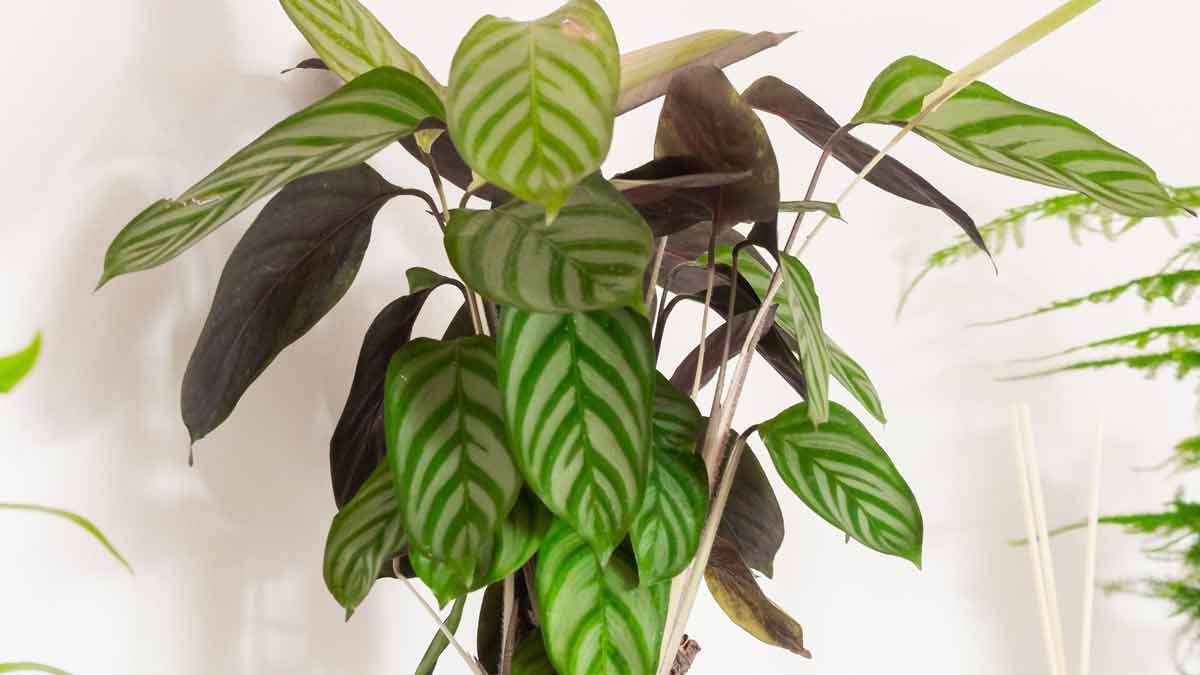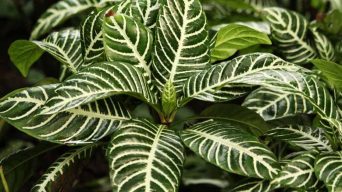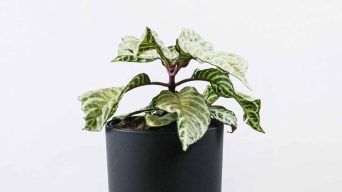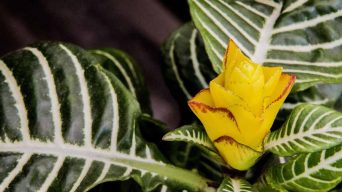Key Takeaways
- Zebra plant leaves turning brown can be caused by incorrect watering practices, exposure to direct sunlight, poor drainage, low humidity levels, nutrient deficiencies, and pests or diseases.
- To prevent brown leaves on your zebra plant: adjust your watering routine and light exposure, improve drainage and increase humidity levels with well-draining potting mix and mulch, and use balanced fertilizer during the growing season but avoid over-fertilization. Also, treat pests/diseases promptly to maintain the optimal health of the plant.
- Trim affected leaves and stems as soon as possible to redirect energy towards healthy growth but disinfect tools before/after use with rubbing alcohol to prevent disease spread. Always monitor your plants’ health regularly.
Are you wondering why your zebra plant leaves are turning brown? Don’t worry; you’re not alone.
Many houseplant owners face this issue and struggle to find the root cause of their beloved plant’s distress.
Brown leaves on a zebra plant can be due to several factors, such as incorrect watering practices, exposure to direct sunlight, poor drainage, or even pest infestations.
This blog post will explore the most common causes behind those discolored leaves and offer effective solutions so your zebra plant can thrive again in good health.
Understanding The Causes Of Zebra Plant Leaves Turning Brown
If you notice brown leaves on your Zebra plant, it could be due to various reasons, such as improper watering, too much sunlight, inadequate drainage, low humidity, lack of nutrients, or pests and diseases.
Incorrect Watering Practices
Incorrect watering practices are among the most common reasons zebra plant leaves turn brown.
Zebra plants require a delicate balance between keeping their soil moist and avoiding overwatering, which can lead to root rot.
On the other hand, overwatering can also cause leaf browning due to poor oxygen circulation around the roots, which leads to root damage and an inability for nutrients to be properly absorbed by the plant.
To prevent these issues, water your zebra plant thoroughly when you notice that its topsoil is dry but ensure proper drainage so excess water doesn’t sit at the bottom of your pot.
Exposure To Direct Sunlight
Exposure to direct sunlight is a common cause for zebra plant leaves turning brown, as these plants thrive best in bright indirect light.
Despite being drought-resistant plants native to South Africa, zebra plants can suffer from sunburn when placed in locations with excessive direct sunlight.
To avoid this issue, it is crucial to provide your zebra plant with an ideal environment that mimics its natural habitat by ensuring it receives enough indirect light while avoiding harsh direct sun exposure.
A good trick is to place the plant near an east-facing window or filter the sunlight through sheer curtains or blinds.
Poor Drainage
Poor drainage is a common issue that contributes to the browning of Zebra plant leaves, stemming from overwatering or inadequate pot drainage.
An excess of water can cause the soil to become waterlogged, depriving your plant’s roots of the oxygen they need to supply vital nutrients throughout the foliage.
To combat poor drainage and maintain your Zebra plant’s health, it’s crucial to implement proper watering practices while ensuring a well-draining potting mix and pots with good drainage holes.
Additionally, monitoring how often you water and adjusting as necessary for seasonal changes can help prevent any unwanted buildup in moisture levels within the soil.
Low Humidity Levels
Low humidity levels can commonly cause brown leaves on your Zebra Plant.
This is because the Zebra plant thrives in high-humidity environments, which mimic their natural habitat.
To combat low humidity levels for your zebra plant, consider investing in a humidifier or placing a tray with water near your plant so that it evaporates and increases the ambient moisture level around it.
Another strategy is to group plants as they release moisture into the air through transpiration, increasing overall humidity levels.
Nutrient Deficiencies
Nutrient deficiencies in the soil can contribute to the brown leaves of zebra plants.
Without proper nutrition, their growth will be stunted, and their leaves may turn yellow or brown.
Common nutrient deficiencies include nitrogen, phosphorus, and potassium.
To address this problem, use a balanced fertilizer formulated for houseplants every two weeks during the spring and summer months when they are actively growing.
Add slow-release fertilizers into your potting mix before planting your zebra plant.
And don’t forget to mix fresh soil every few years as depleted nutrients can lead to browning on zebra plants’ lower leaves but never over-fertilize them.
Too much fertilizer can increase salt buildup in the soil, which is terrible for overall health.
Pests And Diseases
Unfortunately, zebra plants are not immune to pests and diseases that can cause their leaves to turn brown.
Spider mites are a common pest that infests these plants, causing small yellow or white spots on the leaves before they eventually turn brown and fall off.
To treat spider mites, gently wipe down the affected areas with rubbing alcohol or insecticidal soap.
Fungal diseases like corynespora and mesothelium leaf spots can also cause water-soaked lesions on zebra plant leaves, eventually turning brown around the edges.
These diseases thrive in moist environments, so ensure you’re not overwatering your plant and avoid getting its foliage wet when watering it.
How To Treat Brown Leaves On A Zebra Plant
If you observe brown leaves on your Zebra plant, don’t worry. You can take some measures to fix the problem and revive your plant’s health.
These steps include cutting off the affected leaves and stems, modifying your watering and light exposure routine, enhancing drainage and humidity, utilizing fertilizer, and treating for pests or diseases.
Keep reading to know more!
Trim Affected Leaves And Stems
Trimming any affected leaves and stems is important to treat brown leaves on your zebra plant.
Here are some steps to follow:
- Cut off the brown or yellowed leaves as close to the stem as possible using sharp scissors or pruning shears.
- If you notice any stems that have turned brown or mushy, trim them back to healthy tissue.
- Make sure to disinfect your tools before and after use with rubbing alcohol to prevent the spread of disease.
Trimming affected leaves and stems will improve your zebra plant’s appearance and redirect its energy toward healthy growth.
However, it is important to address the underlying cause of brown leaves to prevent further damage.
Adjust Watering Routine And Light Exposure
You can adjust the watering routine and light exposure to treat brown leaves on your Zebra Plant.
Here are some tips:
- Water your Zebra Plant when the top inch of soil is dry.
- Avoid overwatering, as this can lead to root rot.
- Ensure the pot has adequate drainage holes to prevent water from accumulating in the soil.
- Provide bright, indirect light for your Zebra Plant, but avoid placing it in direct sunlight.
- If your plant is near a window, rotate it every few weeks to ensure even growth and prevent one side from getting too much sunlight.
- Consider using a grow light if your plant isn’t getting enough light indoors.
Adjusting these factors can help your Zebra Plant thrive and prevent further brown leaves from developing.
Improve Drainage And Increase Humidity
Improving drainage and humidity levels is essential to prevent brown leaves on your Zebra plant.
Here are some tips:
- Use a well-draining potting mix: Ensure your Zebra plant is planted in a pot with drainage holes at the bottom to allow water to flow out of the soil.
- Adjust watering routine: Water your Zebra plant only when the top inch of soil feels dry. Overwatering can cause root rot and brown leaves.
- Mulch: Adding a layer of mulch on top of the soil helps to retain moisture and improve soil fertility, preventing brown leaves.
- Increase humidity levels: Zebra plants thrive in high-humidity environments, so you can use several methods to increase the humidity around them, such as placing a pebble tray filled with water near the plant or using a humidifier.
- Avoid extreme temperature fluctuations: Keep your plant away from drafty areas and maintain an ideal temperature between 65-80 degrees Fahrenheit.
Use Fertilizer And Treat For Pests and Diseases
To prevent brown leaves on your Zebra plant, monitoring pests and diseases that can damage its health is crucial.
Here are some tips for using fertilizer and treating for pests or diseases:
- Use balanced fertilizer during the growing season: Fertilizing during spring and early summer with a balanced fertilizer can help prevent brown leaves from developing due to nutrient deficiencies.
- Avoid over-fertilization: Over-fertilizing can lead to stunted growth, wilting, yellowing, and brown leaf tips. It’s important not to use too much fertilizer or fertilize too often.
- Treat for pests: Spider mites and other pests can cause Zebra plants to develop brown spots and discolored foliage. Use a suitable insecticide to treat any infestations in the early stages.
- Treat for diseases: Diseases like root rot, bacterial leaf spot, and fungal infections can cause brown leaves on Zebra plants. Using a copper-based bactericide can help treat unaffected foliage, soil, and neighboring plants affected by diseases associated with brown leaves on the Zebra plant.
- Monitor plant health regularly: Keeping track of your plant’s health will help you catch any issues before they become severe. Spotting problems early allows you to take corrective measures promptly, preventing further damage that could lead to brown leaves on your Zebra plant.
Avoid Over-fertilization
Over-fertilizing your zebra plant can be just as damaging as under-fertilizing it.
Too much fertilizer can cause leaf burn and lead to brown spots on the leaves.
It’s important to only feed your plant once every two weeks in spring and summer with a diluted liquid houseplant fertilizer.
Be sure to follow the instructions on the package carefully and avoid giving it more than recommended.
Additionally, you should not fertilize your zebra plant during fall and winter, as it becomes inactive.
Tips For Preventing Brown Leaves On A Zebra Plant
Following a few key steps is essential to keep your Zebra plant healthy and prevent brown leaves.
These include watering correctly, ensuring proper lighting and humidity levels, using an appropriate potting mix, fertilizing regularly while monitoring plant health, and avoiding overcrowding.
By taking these measures, you can help ensure that your plant thrives and stays vibrant.
Water Correctly And Monitor Drainage
One of the most common causes of brown leaves on your Zebra Plant is overwatering or poor drainage.
To properly care for your plant, water it correctly and monitor its drainage. Here are some tips to follow:
- Always use a well-draining potting mix to prevent water from pooling around the roots.
- Ensure your pot has proper drainage holes to allow excess water to escape.
- Water your Zebra Plant once a week, ensuring the soil is only slightly moist but not saturated.
- Avoid letting your plant sit in standing water, leading to root rot.
- Adjust your watering routine accordingly if you notice any signs of poor drainage or overwatering.
Provide Proper Light And Shade
Zebra plants require just the right amount of light to thrive; improper lighting conditions can lead to brown leaves.
Here are some tips for providing the appropriate light and shade for your zebra plant:
- Place your zebra plant in a bright location, but avoid direct sunlight, as it can cause the leaves to burn and turn brown.
- If you don’t have a spot with bright indirect light, you can supplement it with artificial grow lights.
- Rotate your zebra plant every few weeks to ensure all sides receive enough light.
- Provide shade during the hottest part of the day or if your zebra plant is near a window that receives intense sunlight.
- Keep an eye on the temperature around your zebra plant, as excessive heat can also damage the leaves. Ideally, keep it in a room with temperatures between 65-80 degrees Fahrenheit.
Increase Humidity Levels
Increasing the humidity levels around your Zebra plant is crucial in preventing brown leaves.
Here are some practical ways to increase moisture in the air:
- Mist your plant regularly: Use a spray bottle to mist the leaves of your Zebra plant once or twice a day, especially during dry winter months.
- Place a pebble tray: Fill a shallow tray with pebbles and water, then place the pot on top. The water will evaporate, increasing humidity around the plant.
- Use a humidifier: This is an ideal option for larger plants as it can provide consistent and controlled moisture levels.
- Group plants together: Placing several plants in one area can help increase humidity levels as they release moisture through transpiration.
Fertilize Regularly And Monitor Plant Health
To keep your Zebra Plant healthy and prevent brown leaves, it is essential to fertilize it regularly and monitor its overall health.
Here are some tips on how to do this:
- Feed your Zebra Plant with a balanced fertilizer during its growing season, typically from spring to fall. Use a water-soluble or slow-release fertilizer that is high in nitrogen and potassium.
- Do not fertilize the plant during winter as it goes into dormancy and does not require much nutrient intake.
- Remember to dilute the fertilizer before application, as over-fertilization can also cause brown leaves.
- Monitor the overall health of your Zebra Plant by checking for any signs of pests or diseases, wilting, yellowing or browning of leaves, and leggy growth.
- If you notice any issues with your plant’s health, immediately trim away affected leaves and stems, adjust the watering routine and light exposure, improve drainage and increase humidity levels, use an appropriate potting mix, and treat pests/diseases.
Use A Suitable Potting Mix
Choosing the right potting mix prevents brown leaves on your Zebra plant.
A well-draining potting mix that allows excess water to drain away from the roots is ideal for this type of plant.
Avoid using heavy or compacted soils as they can cause poor drainage and lead to root rot.
If you’re unsure which potting mix to use, look for ones labeled explicitly for succulent plants or drought-tolerant plants like Zebra plants.
Avoid Overcrowding
It is important to give your zebra plant enough space and avoid overcrowding.
When plants are cramped in a small pot or placed too closely together, they become stressed and more vulnerable to diseases and pests.
Overcrowding can also lead to poor air circulation, which can cause problems with humidity levels and create an environment where fungal growth thrives.
Make sure to choose a pot that allows for proper drainage and ample room for the roots to grow.
If your zebra plant has outgrown its current pot, consider repotting it into a larger container with fresh soil.
Final Thoughts
Brown leaves on your Zebra plant can indicate immediate problems.
Correct watering practices, proper light exposure, and maintaining optimal humidity levels are crucial to ensure the health and well-being of your plant.
Always avoid over-fertilization, treat pests and diseases promptly, and provide adequate drainage in the potting mix.







